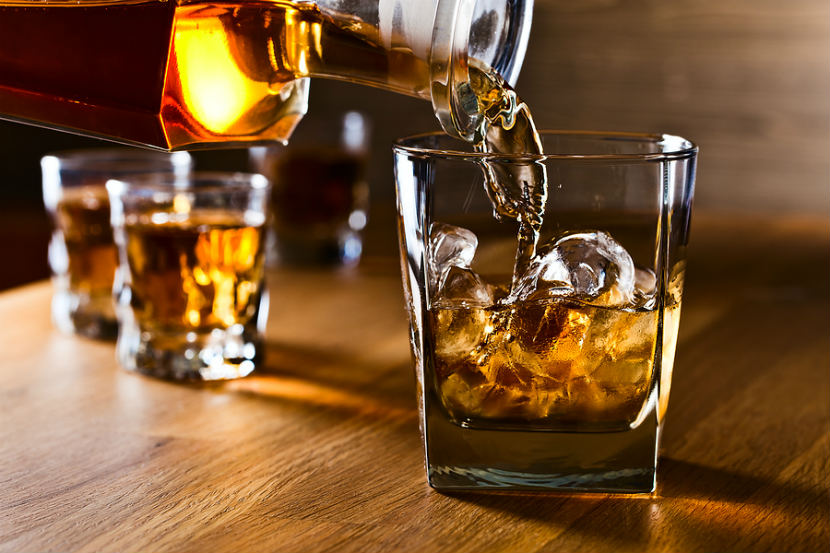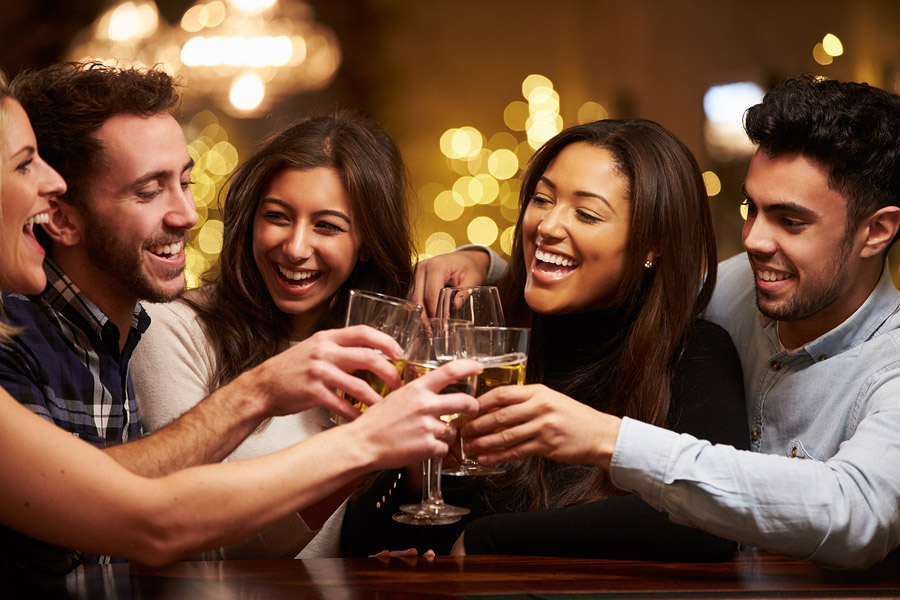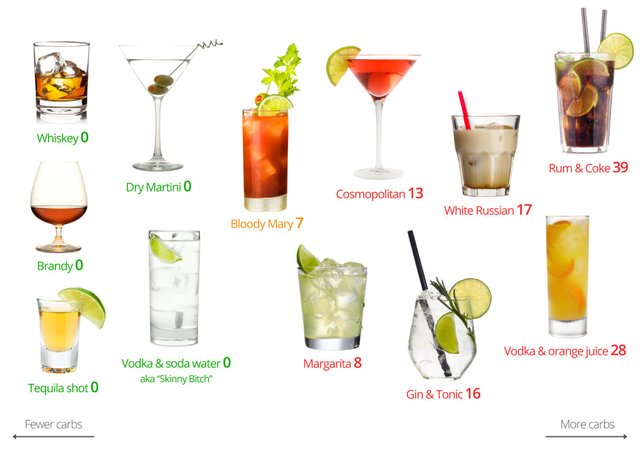Alcohol: How it is affecting your weight
So you’ve been exercising regularly, and cutting back on your calories to meet your weight loss goals. Everything is going great with your new changes but you notice the number on the scale isn’t moving much and your body isn’t changing shape as quickly as you’d hoped. There may be one more habit interfering with your weight loss efforts. It's alcohol.

Perhaps you enjoy a glass of wine with dinner, have a couple of beers while watching the big game, or even cocktails on a Saturday night with friends. All common practices but they may be getting in the way of your weight loss efforts.
Alcoholic beverages have been enjoyed throughout recorded history. For some, a drink with dinner may be relaxing. Others may enjoy the inhibitions that alcohol can create to “let loose” with friends. Many people drink for the health benefits. After-all, evidence shows that moderate drinking, especially red wine, may lower the risk of heart disease. No matter what your reasons are for drinking, alcohol can interfere with your weight loss goals.
Alcohol is a product of fermenting carbohydrates- both sugars and starches. This means it does provide calories. Specifically it provides 7 calories for every gram compared to 4 calories per gram of carbohydrates and protein, and 9 calories per gram of fat. Drinking 4 (12 ounce) beers will supply 600 calories. To burn those calories, a person would need to walk non-stop for 3 hours. Skipping the cab ride and walking home may be a strategy but for most of us a 3 hour walk is a bit daunting even when we are in good shape.
The calories found in the average alcoholic drink are quite concentrated compared to many foods, and this actually causes one to inadvertently take in many more calories than would otherwise be consumed. Alcohol is quite deceptive in that it passes through the system rapidly, often before the drinker is aware of the number of drinks they have had.
Alcoholic drinks also contain calories from other sources, which add to overall caloric intake. Certain cocktails, for example, contain fats. Wine and beer both have high carbohydrate content. Although the affects these various calorie types have on the body are different—carbohydrates release insulin, which can hasten fat storage, while fats will be stored directly in the fat cells—the overall result is added body fat.

Although wine contains fewer calories than beer, this can also lead to extra calories. Having a glass of wine provides 100 calories, but this is dependent on the glass size. A serving size of wine is 5-ounces. The larger wine glasses hold about 10 ounces turning your one glass of wine into two glasses. To put this into perspective, drinking two glasses of wine each night with dinner will add an extra 200 calories each day. If these calories are not burned through exercise and daily activity it can lead to a 20 pound weight gain in a year.
Adding juice, creams, and sodas to cocktails will increase the calorie level beyond what the alcohol is already providing. Be careful of what you are drinking. In some cases, one drink provides more calories than an entire meal! Here are the drinks that top the scales for most calories-
Long Island Iced Tea: 780 calories
Margarita: 740 calories
Pina Colada: 644 calories
White Russian: 425 calories
Sex on the Beach: 356 calories
Mai Tai: 350 calories
Lemon Drop: 223 calories
Besides adding calories, alcohol may affect your weight for other reasons. Some evidence suggests drinking alcoholic beverages may stimulate your appetite and cause you to eat more than you normally would. A Canadian study showed that alcohol consumed before a meal increased caloric intake to a far greater extent than did a carbohydrate drink. Also, researchers from Denmark's Royal Veterinary and Agricultural University showed that if a group of men were given a meal and allowed to eat as much as they wanted, alcohol, rather than a soft drink, would increase the amount of food consumed.
It also decreases your inhibitions so you don’t care how much more you are eating. The result of this relaxed thinking could mean more calories consumed and extra body fat gains. Those drinking might also eat more of the wrong kinds of food, without thinking of the consequences. How many times have you enjoyed chips and salsa with your margaritas while out with friends? How many chips did you eat? Who knows- all you remember is the waiter bringing three or four refills of the chip bowl.
Testosterone, which has a powerful fat loss effect, is reduced whenever alcohol is consumed, thus halting its full potential as a fat burner. Also, testosterone as an anabolic hormone, contributes to gains in lean muscle mass. Lowered testosterone means fewer muscle gains, and less muscle means a lowered metabolic rate.
Another factor to take into account is that your body processes alcohol first, before fat, protein, or carbohydrates which may slow down the burning of fat. There is also evidence that drinking too much seems to increase fat carried in the stomach area- otherwise known as the beer belly. Studies show that people with a higher amount of fat in the abdominal region are at a greater risk of heart disease.
Ok, this is looking dreary but it doesn’t mean you can never enjoy alcohol again. It just means that it is time to take inventory to see how much you are drinking and pay attention to how many calories your favorite drinks supply. Learn how to enjoy alcohol in moderation so you don’t end up sabotaging your weight loss efforts.

If you really have to drink, what are the best choices? Some lower calorie brands to hit the market are showing promise, as are some of the more traditional alternatives.
As shown above, total caloric content of various alcoholic drinks varies, with beer generally containing the highest number, considering the smaller amount of alcohol found in this drink compared with others. Various spirits (also known as liquor) generally contain around 64 calories per nip, but these do add up depending on the strength of the drink (for example, a double will contain two nips, or 128 calories).
Combine this with one glass of coke (around 180 calories, 95% of these from sugars) and your typical bourbon and coke could supply 308 calories—double the number found in the average can of beer. Wine generally contains around 100 to 125 calories per medium sized glass. It also contains more alcohol than beer given the same volume, making it a better choice calorie-wise, as less would be consumed at any one sitting.
Liqueurs, although usually around 100 calories per nip, are often consumed with other, often-higher calorie mixers such as coke or milk to make cocktails, bumping the calorie content way up. Baileys Irish Creme, one of the highest calorie alcohols, contains 121 calories per nip, with a comparatively low alcohol content (17% compared to around 25-35 for most liqueurs). It is usually consumed 2-3 nips at a time given its lower alcohol strength. It is definitely one worth avoiding if weight loss is the aim.
The worst alcohol choices would be the cream based drinks such as eggnog (340 calories without the alcohol) and an Amaretto Sour (includes tequila and orange juice and contains 421 calories). The highest calorie cocktail of the all would be the Vodka Mudslide, which contains coffee liqueur, Irish cream and vanilla ice cream and supplies 820 calories.
It would be better to drink a smaller quantity of liqueur with a healthier, lower calorie base such as trim milk or tomato juice (the latter being the base for a Bloody Mary cocktail).
Given alcohol taste is an individual matter, and people will usually choose what they like, rather than what they are advised to consume based on the health content of the drink, it is no easy task trying to persuade someone to change their drinking habits. The above information can however be used by one who is wanting to make some physical changes by lowering the overall caloric content of what they drink.
Some more general guidelines follow:
Drink alcohol with a lower caloric value, and a higher alcohol percentage (like wine for example). Less will be consumed, meaning lower overall calorie consumption.
Avoid high-calorie liqueurs. These are extremely deceptive (they taste so good) and will add enormously to overall caloric content.
Keep healthy food on hand when drinking. As mentioned, drinking will relax the inhibitions and cause one to compromise their nutritional habits.
If drinking beer, try a lower calorie alternative. Also, drink diet sodas with various spirits to significantly lower the calorie content of these drinks.
Drink water between alcoholic drinks. This will increase feelings of fullness and may help to prevent over consumption of alcohol.
Low Carb Alcoholo

Conclusion
So what is one to do? Given alcohol plays a large role in celebration and social cohesion, can one completely refrain from its use? It really depends on the goals a person has. Most could probably consume moderate levels of alcohol (two or three standard drinks three to four times per week) without any problem.
Drinking alcohol is injuries to health.
Hi! I am a robot. I just upvoted you! I found similar content that readers might be interested in:
https://www.bodybuilding.com/content/5-ways-alcohol-hinders-fat-loss.html
good post.
really nice man
alchol?
really great
This post was resteemed by @steemitrobot!
Good Luck!
The @steemitrobot users are a small but growing community.
Check out the other resteemed posts in steemitrobot's feed.
Some of them are truly great. Please upvote this comment for helping me grow.
onak valo akta post ....
nice and full of informative article brother
Congratulations @physioarefin! You have completed some achievement on Steemit and have been rewarded with new badge(s) :
Click on any badge to view your own Board of Honor on SteemitBoard.
For more information about SteemitBoard, click here
If you no longer want to receive notifications, reply to this comment with the word
STOP